The Microsoft Surface Laptop 4 15-Inch Review: Refreshing Ryzen
by Brett Howse on May 6, 2021 8:00 AM ESTDisplay Analysis
One area where Microsoft has really focused on is displays, basically since the Surface Pro 4 and Surface Book launched back in 2016. Since that time, they are one of the very few manufacturers to hardware calibrate every display at the factory. Microsoft has also embraced the 3:2 aspect ratio across the entire Surface lineup, from the diminutive Surface Go, all the way up to the 28.5-inch Surface Studio. On notebook computers, the extra height offered by the taller screen provides a better workflow for most tasks, although it does increase the letterboxing for viewing media that is delivered in 16:9.
 Surface Laptop 4 Subpixel Arrangement
Surface Laptop 4 Subpixel Arrangement
Although there have been some devices pushing display technology more quickly than Microsoft, it is not always for the benefit of all users all the time. Microsoft has stuck with sRGB gamut displays, when many competitors offer displays with the wider gamut P3-D65 support, or Adobe RGB. Some displays offer Dolby Vision, and some offer HDR, but sadly, none of those technologies make PC displays better all the time.
As I have discussed many times in the past, Windows 10 lacks proper color management support for the entire display pipeline, and as such, moving away from the expected sRGB color gamut on the PC is a challenge, and can result in many unwanted repercussions. Applications must explicitly support wide-gamut color, and since most do not, the experience is less than ideal. While it would be nice for the Surface team to address this, to this point, they have not. So, for today, sRGB is the best choice for most of the people, most of the time.
The 3:2 display on the Surface Laptop 4 offers a resolution of 2496x1664 pixels, which works out to 201 pixels per inch. It can’t match the 260 pixels per inch of the much more expensive Surface Book, but the display density is a nice compromise between clarity, cost, and performance. Microsoft also includes two color profiles, with sRGB, and Enhanced, which tweaks the colors to be a bit more vivid, although at the cost of accuracy. Most people will likely prefer this option though.
To test the display characteristics, we use Portrait Displays Calman software with a custom workflow. For brightness and contrast measurements, we use the X-Rite i1Display Pro colorimeter, and for color accuracy testing, we use the X-Rite i1 Pro2 spectrophotometer.
Brightness and Contrast
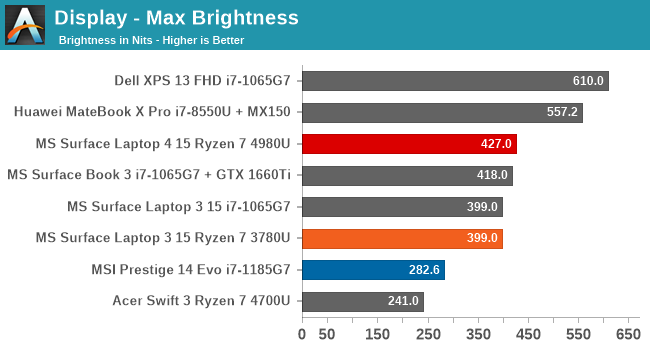
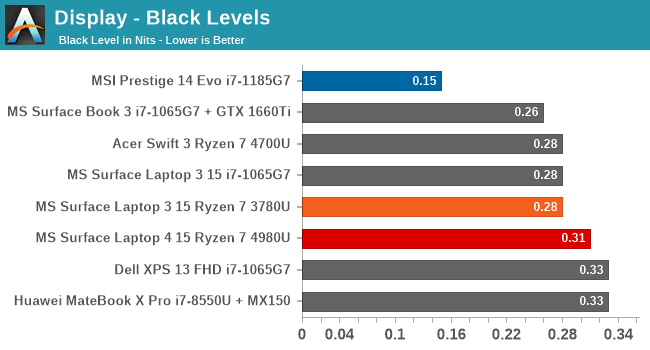
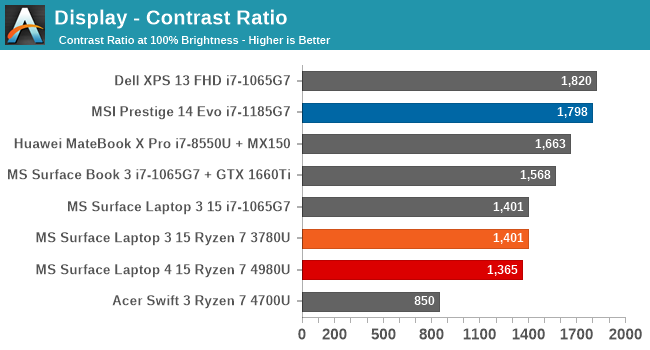
At 427 nits, the Surface Laptop 4 gets quite bright, although it is nowhere near the Dell XPS 13, and the Dell also has one of the best anti-reflective coatings in the PC space, making it a superior device for outdoor use. But there is still plenty of brightness for most use cases. Black levels are good, but the overall contrast ratio can not match the best displays on the market, which is a shame. The display goes all the way down to 6.7 nits, so the brightness range is quite wide.
Grayscale
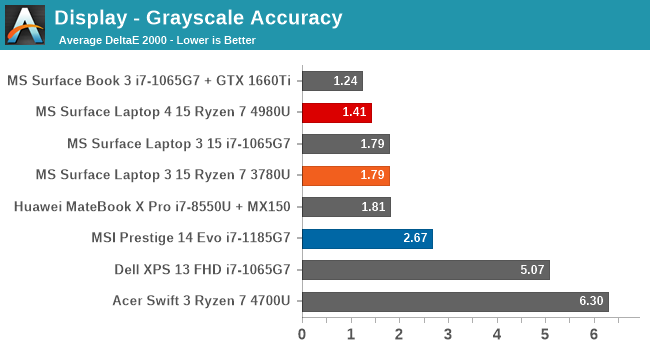
With years of experience calibrating every display panel they offer; it is no surprise to see the Surface Laptop 4 results having excellent accuracy. Grayscale is one area that can be tightened up with a custom ICC profile, but it is really not needed when purchasing a Surface device, as they are all good out of the box.
Gamut Accuracy

Color accuracy at the 100% levels for the primary and secondary colors is spot on with this device.
Saturation
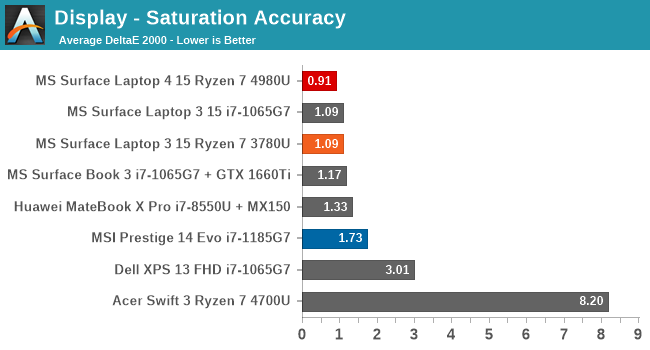
Unlike the Gamut test where the primary and secondary colors are tested at the 100% levels, the saturation test increases the test points to 4-bit steps from 0-100%. Again, the Surface Laptop 4 is superb here.
Gretag Macbeth
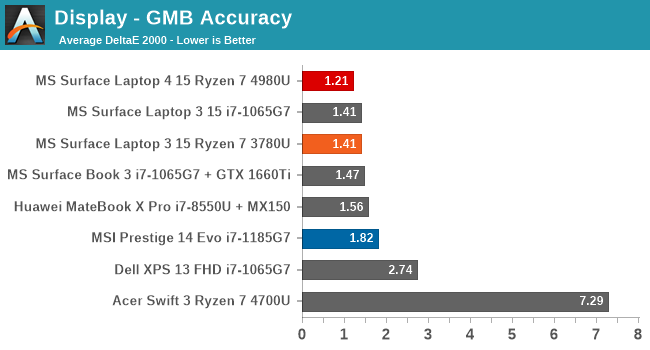
The final test moves away from just testing the primary and secondary color axis, and tests colors from across the spectrum, including the important skin tones. The results are excellent, again. No single color even hits the 3.0 error level.
Colorchecker
The final image is the relative colorchecker, where the target color is on the bottom of the swatch, and the displayed color is on the top. The error levels are almost imperceptible to the human eye, and showcases the reason why factory calibrating the display is so valuable.
Display Conclusion
Although the Surface Laptop 4 does not offer the current display buzzwords of HDR, Dolby Vision, or DCI-P3 gamut (which is technically an incorrect term on the PC, but does not stop the marketing departments from using it) the Surface Laptop 4, as usual with a Surface device, delivers some of the most accurate colors of any device out of the box.
If you want a device to edit photos or videos, having an accurate display can be critical to your workflow, and this is where the Surface lineup really shines. With every generation, and every price point, every Surface device offers a very solid display, and is one of the best reasons to consider one. The 3:2 aspect ratio is also a win for productivity tasks, especially compared to 16:9 devices.


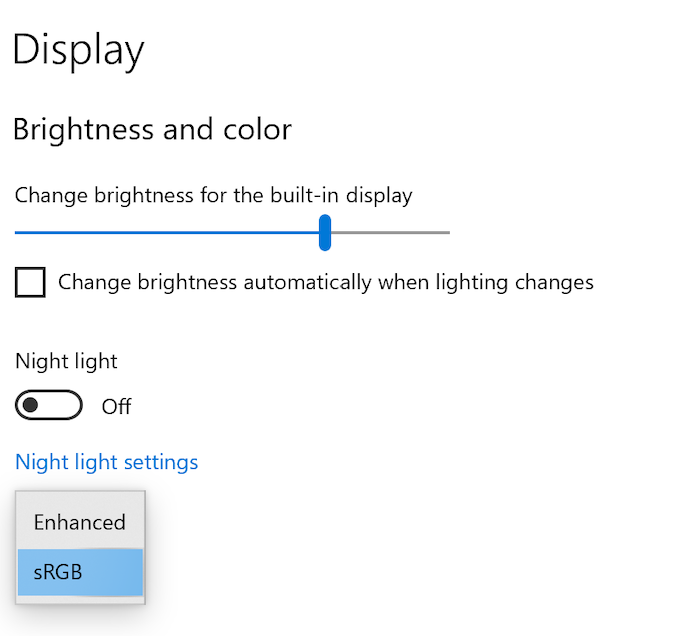













98 Comments
View All Comments
Reflex - Thursday, May 6, 2021 - link
This list is silly. Almost all of the things you mention are mostly accessed wirelessly these days. USB-A to USB-C adapters are super cheap and Anker sells a nice line of USB-C hubs that provide additional ports if you truly need them. I have one in my bag due to my Dell laptop having only 2 USB-C ports, but I can't even remember the last time I needed to use it.There are excellent actual bluetooth mice out there, I use a Microsoft one.
Who is using their optical drive on the go, or really at all?
Your storage is better in the cloud or on the network, again how most people use it nowadays.
Also, printers, can you even buy a decent printer that isn't wireless now?
And again, bluetooth keyboards are a thing and they are cheap.
Just bizarre list. Reads like someone stuck in computing from 15 years ago.
If this is your list of needs, modern ultrabooks are not for you.
Kevin G - Thursday, May 6, 2021 - link
Or people reasonably can't afford to repurchase everything. A cheap just to get it done wired mouse can be had for as little as $5 where as a good BlueTooth mouse starts at $20. The kicker is that people already have a wired mouse they could plug-in and use. Yeah, $20 in the grand scheme of things but when you have pay that extra amount five or six times, it starts to get noticed by the masses especially on top of the price of a new ultrabook.Ditto for printers. If you've saved up and purchased a unit years ago and is humming along nicely, why replace it with something new? At some point it does make sense to upgrade due to the lack of ink/toner available on the market or it just breaks down, but realistically things can last a very long time.
My Dell 5540M I'm currently using has two USB-A and one TB3 port and I often find myself limited. I use a lot of hardwired networking to isolated networks so there goes one port dedicated to that. The wired networking port generally gets the TB port even though it is type-A and I'll need an A-to-C adapter. One Type A goes to a wired mouse since it also doubles as a mouse for some systems that either have BT disabled or no wireless connectivity at all (and i'm not going to carry a second one if i don't have to). The remaining type A is often used for removable storage or a wired audio device. Thankfully I still have a dedicated barrel power jack. The TB3 port also supports power in a pinch and I borrowed other people's type-c chargers in an emergency. There are indeed times where I wish I had four USB ports.
I also do have access to a USB external optical drive which I pull out once or twice year to access an old physical media file. I've probably had this over half a decade with the same relative pace of usage and probably will keep on to it until it break at what point I imagine it'll pass the decade mark. My coworkers know I have it and again a few times a year one will ask to borrow it for a similar one-off data transfer. Migrating data to the network/cloud is a generally a good idea but it takes time, has costs (and monthly costs for the cloud) associated for it and a small amount of skill on the user's end.
simonpschmitt - Friday, May 7, 2021 - link
While your desccribed use case seems to need more (USB) ports at times most of it could be managed by a cheap USB-hub.Additionally, you must admit that this is beyond propably 99% of computer users out there.
Most people don't use one mouse for more than one computer.
Actually everyone I know outside IT does not use wired networking on a mobile device.
For my sisters (both teachers) and parents (small buisness owners) switching everything possible to wireless was propably the best quality of live upgrade since they use computers.
Kevin G - Monday, May 10, 2021 - link
Hubs can be problematic vs. having the port natively in a device. Large capacity hubs or those that can power other devices require AC outlets. Small data only hubs exist but generally are not the highest quality. Hubs also run the risk of some one tripping over a cable and unplugging everything off of that hub (uplink is disconnected) vs. a single device. A single home run to the host device is strongly preferred where every possible. This also applies to various adapters from say USB-C to DisplayPort: a single cable with the proper ends is preferred over a USB-C to female DP port and a DP-to-DP cable. Simply less to go wrong in the single path and you carry around less.Wired networking is critical for me as I often work on isolated, wired networks. There have been at times where I've been on two independent wired networks and still had wi-fi going. I realize that my use-case is rather specific but it does drive home the more general idea that the number of USB ports on a system is restrictively small, especially if they're pulling double duty for the likes of power, video, audio and networking.
PaulMack - Thursday, May 6, 2021 - link
I've had a Surface for some time and, while the limitation to one USB port is occasionally annoying, it's never been for a mouse. It's a premium device, and it's not unreasonable to spend $/£/€50 on a Bluetooth mouse. I only ever hit the limit when connecting a memory stick and another peripheral, and that's rare when on the move without the dock.MrCommunistGen - Thursday, May 6, 2021 - link
You can get a pretty inexpensive travel USB-A 3.0 hub for less than $20. I just keep one in my travel bag. A quick search turned up two different 4-port models for $13-15.yankeeDDL - Friday, May 7, 2021 - link
By "expensive adapter" you mean something like this (25usd)? https://www.amazon.com/-/es/Adaptador-USB-Hub-Mult...Using more than 2 USB port at the time is quite rare. Yes, more ports would help, but clearly teh space is rather limited.
Spunjji - Friday, May 7, 2021 - link
If you're using an external optical drive and a printer then you can probably handle using a hub, too.29a - Friday, May 7, 2021 - link
People giving presentations often need more than one USB port which I can see this laptop being used to give a lot of presentations. A flash drive and a Powerpoint presenter are both commonly used when giving presentations, that's two USB ports there.philehidiot - Sunday, May 9, 2021 - link
Typical use case for a business machine - running software that requires a USB dongle to operate. Removing it disables the software. One port down. Need to charge? Both down. How about people who leave a low profile USB drive in a slot for local back up purposes? If my livelihood is based on what is on that machine, I've got a local backup running as well as cloud.Sure, plug in a USB C dongle with a wire and giant block with all the connections you'll need (because having a different one for every use is expensive and fiddly) and you'd better not be using the laptop on your lap on a train or in a car. It'll dangle off your lap, yanking on the port constantly.
A business laptop, in my humble opinion, should have three available ports as a minimum. But as others have said here, they are likely working on feedback from telemetry and real world use. 95% of people don't use it so screw 5%.
In my view, a business laptop like this, with such an asking price should be putting in the extras that ensure more than the bare minimum for the majority. The people who have a use case as I have suggested above simply won't buy it, so it won't be their problem.